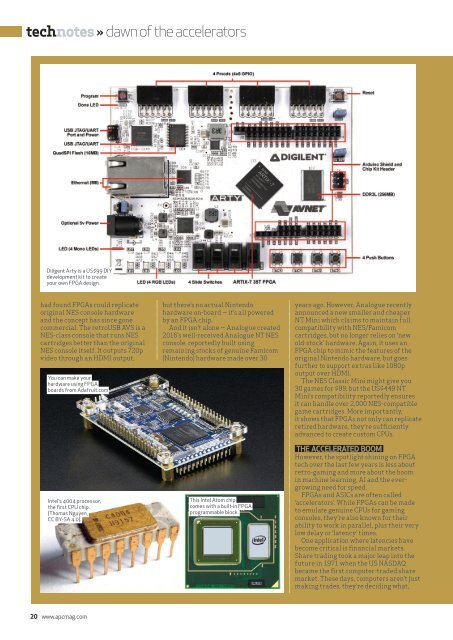You also want an ePaper? Increase the reach of your titles
YUMPU automatically turns print PDFs into web optimized ePapers that Google loves.
technotes » dawn of the accelerators<br />
Diligent Arty is a US$99 DIY<br />
development kit to create<br />
your own FPGA design.<br />
had found FPGAs could replicate<br />
original NES console hardware<br />
and the concept has since gone<br />
commercial. The retroUSB AVS is a<br />
NES-class console that runs NES<br />
cartridges better than the original<br />
NES console itself. It outputs 720p<br />
video through an HDMI output,<br />
You can make your<br />
hardware using FPGA<br />
boards from Adafruit.com<br />
Intel’s 4004 processor,<br />
the first CPU chip.<br />
(Thomas Nguyen,<br />
CC BY-SA 4.0).<br />
but there’s no actual Nintendo<br />
hardware on-board — it’s all powered<br />
by an FPGA chip.<br />
And it isn’t alone — Analogue created<br />
2016’s well-received Analogue NT NES<br />
console, reportedly built using<br />
remaining stocks of genuine Famicom<br />
(Nintendo) hardware made over 30<br />
This Intel Atom chip<br />
comes with a built-in FPGA<br />
programmable block.<br />
years ago. However, Analogue recently<br />
announced a new smaller and cheaper<br />
NT Mini which claims to maintain full<br />
compatibility with NES/Famicom<br />
cartridges, but no longer relies on ‘new<br />
old-stock’ hardware. Again, it uses an<br />
FPGA chip to mimic the features of the<br />
original Nintendo hardware, but goes<br />
further to support extras like 1080p<br />
output over HDMI.<br />
The NES Classic Mini might give you<br />
30 games for $99, but the US$449 NT<br />
Mini’s compatibility reportedly ensures<br />
it can handle over 2,000 NES-compatible<br />
game cartridges. More importantly,<br />
it shows that FPGAs not only can replicate<br />
retired hardware, they’re sufficiently<br />
advanced to create custom CPUs.<br />
THE ACCELERATED BOOM<br />
However, the spotlight shining on FPGA<br />
tech over the last few years is less about<br />
retro-gaming and more about the boom<br />
in machine learning, AI and the evergrowing<br />
need for speed.<br />
FPGAs and ASICs are often called<br />
‘accelerators’. While FPGAs can be made<br />
to emulate genuine CPUs for gaming<br />
consoles, they’re also known for their<br />
ability to work in parallel, plus their very<br />
low delay or ‘latency’ times.<br />
One application where latencies have<br />
become critical is financial markets.<br />
Share trading took a major leap into the<br />
future in 1971 when the US NASDAQ<br />
became the first computer-traded share<br />
market. These days, computers aren’t just<br />
making trades, they’re deciding what,<br />
20 www.apcmag.com


















